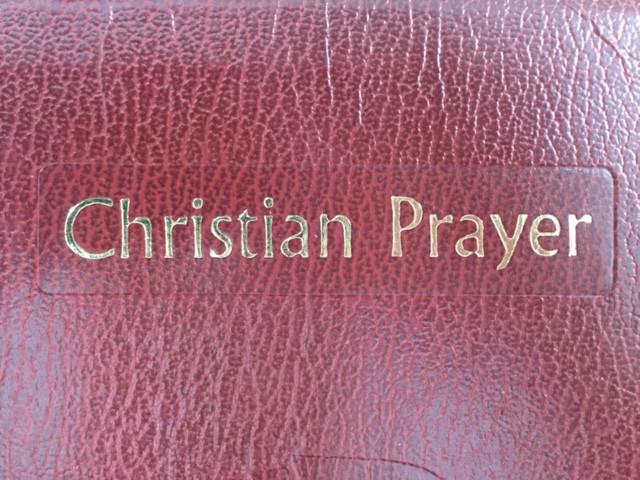–> Fight Distractions! A step-by-step guide on how to stay focused during prayer
Today, I will walk you through the most common prayer book lay people can pick up to pray the principal hours of the divine office: Christian Prayer. It contains: Morning, Evening & Night Prayer, with an abbreviated section for the Office of Readings and Daytime Prayer. If you only have enough time to pray one or more of those prayers, I suggest picking-up Christian Prayer.
First of all, as with any breviary, there are the all-important “ribbons.” These are extremely important and allow you to mark the correct parts of the divine office.

To begin setting the ribbons, take one of them and open to page 686 where the “Ordinary” and “Invitatory” are located. The “Ordinary” is the basic “instruction manual” for the Liturgy of the Hours and acts as a reference point if you ever get stuck.

Here we see how the common phrase “Say the Black, Do the Red” comes in handy. All the words printed in the color red are your instructions and all the words printed in black are the prayers you actually pray. There are plenty of instructions and options, so read it all very carefully. I suggest reading through the entire “Ordinary” before going any further.
The “Ordinary” also has prayers that are repeated each day such as the “Magnificat” and “Benedictus.” You pray these at Evening and Morning Prayer and are typically memorized in the monastery. Until you have them memorized, you can always turn to the “Ordinary” to find them.
After you have read the “Ordinary,” you can leave your first ribbon where it says “Invitatory.” This is composed of an antiphon and Psalm 95 and is typically prayed before Morning Prayer (or the Office of Readings). If you are praying the Invitatory on your own, you will say the correct antiphon once, pray Psalm 95 and then recite the same antiphon at the end. When with others, you will recite the antiphon after every stanza.
Before we go any further, a note about Christian Prayer. Unlike the full version of the divine office, the antiphons are only printed once at the beginning of each Psalm. That means after praying a Psalm, you will have to flip the page backwards to recite the correct antiphon. This is important to remember and will be repeated in Morning Prayer, Evening Prayer, etc.
The second ribbon will be located in the front of the breviary in a section called the “Proper of Seasons.” This section of the breviary has all the prayers according to the “seasons” of the Church: Advent, Christmas, Lent, Easter & Ordinary Time.

Typically it has special antiphons and prayers for the hours prayed on Sundays throughout the year. During seasons such as Lent, there are specific readings and prayers for each day.
For now, you can place the ribbon on page 344. You will see that it says, “Fourth Week of Lent” and “Monday, Morning Prayer” at the top of the page. In order to figure out what week it is, go to USCCB.org and click on their calendar. Alternatively, you can order your own wall liturgical calendar that says what day it is.
This is an important part of the breviary as when you reach the next Sunday, it says what “Psalter” you are currently in:

You will see that it reads “Psalter, Week IV” below “Fourth Sunday of Lent.” This indicates where to put your third ribbon.

This third ribbon is located in the middle of the breviary and for our purposes is located on page 937. You will see that it reads, “Monday, Week IV” and is where we want to be. If you ever get confused on which “Psalter” you are supposed to be in, go back to the “Proper of Seasons” and the correct Sunday will tell you.
The fourth ribbon should be located at the current day for “Night Prayer.” Which is much easier to understand, as it only has a single cycle that is repeated each week. For today, it is located on page 1041.

The fifth ribbon can be placed in the “Proper of Saints,” which contains the special prayers and antiphons for specific saint days. All you need to know is the calendar date to know where to put the ribbon. Today it is located on March 7th, the Memorial of Perpetua and Felicity.

Once you have all of the ribbons in place, you can start praying every day and go through it one page at a time. If you ever get lost or confused, go to the “Ordinary” and it will tell you what to do.
At first it can be quite confusing, but after several weeks of praying it goes much smoother. After several years of praying, it is like riding a bike. If you have any trouble, I am more than happy to help as well.
Praying in this manner, while more difficult than opening up an app, is very beneficial. In an age where everything is available at the touch of our finger, it is healthy to learn the “art” of praying the divine office.
Read More: An introduction to the four-volume breviary
Read the Entire Series:
- Physical Breviary vs. iBreviary: How is a Person to Pray?
- The Digital Breviary: A Guide to Praying the Divine Office in a Digital World
- 5 Reasons to Pray the Divine Office Daily
- 5 Practical Ways to Prepare for Mass
- How to Actively Participate in Mass
- 3 Ways to Imitate Jesus’ Vocal Prayer
- How to Pray Like Jesus: The Ultimate Checklist

